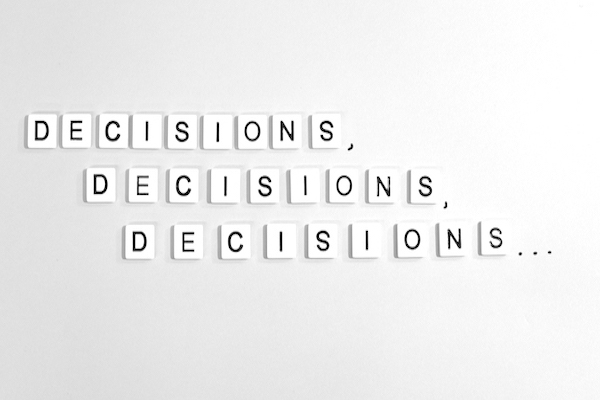
Podcast #11: Decisions, Decisions, Decisions with Joseph Campbell & Adam Grant
CLICK HERE TO LISTEN TO PODCAST EPISODE
We are part of a universal cycle of birth, transformation, and death. This cycle is repeated metaphorically throughout our lives, over and over again. You take on a challenge, you transform through some ordeal, your previous existence dies, and you’re reborn in some altered form: birth, transformation, death, rebirth. This is what life is all about—trials, tribulations, triumphs, and ongoing transformations. From child to adult, from single to married, from married to parent, from amateur to professional, from employee to entrepreneur, from Anakin Skywalker to Darth Vader, it goes on and on and on.
To be a hero—someone who gives your life to something bigger than yourself, whether it be in your own mind or the minds of others—you must take on challenges. The goal of these challenges is to create and then share your creations for the benefit of something larger than yourself. This is part of our DNA, whether it be manifesting our own journey or engaging with someone else’s. It’s why we’re so enthralled with the achievements of others, whether they be sports stars, entrepreneurs, or just children playing a new song on the piano. It’s what we do, it’s what we want to do, and it’s what makes us feel most fulfilled.
The problem is that most of us don’t have a framework to approach our hero’s journey, to choose our challenge. And we’re principally concerned with our selfish desires, not understanding that our success and fulfillment are wholly dependent on serving a larger purpose.
Successful individuals and organizations not only have a deeper connection to their purpose, they manifest frequently and regularly, giving them many more opportunities to realize their potential. As author Adam Grant points out in his book Originals, “Creative geniuses weren’t qualitatively better in their fields than their peers. They simply produced a greater volume of work, which gave them more variation and a higher chance of originality.” Not every act of creation is going to lead to success, but the likelihood of you creating something truly special increases exponentially the more you create. That is how you become creatively experienced.
CLICK HERE TO LISTEN TO PODCAST EPISODE
What this means is that you must consistently be choosing challenges, a routine you repeat throughout your life, in which you identify the best possible challenge available at any given moment and work to overcome that challenge. After all, as world-class chef Ferran Adrià says, “That is what life is, a struggle to reach a challenge.” This idea is at the core of who we are. Why do we play games or sports? They’re challenging, and we want to win or go on to the next level. Why do we gamble? It’s a never-ending challenge that stimulates us. As humans, these challenges are what give us meaning; they’re what we enjoy. Our broader life is no different. Why do you pursue a mate? It’s a challenge, and it feels spectacular when you overcome that challenge. The problem is, most of us don’t realize that’s when the real challenge begins.
But challenges can also be our undoing. When we pursue the wrong challenge—one not aligned with our purpose and not building on our experience—we become unbalanced, and we won’t be able to unlock our potential. And that’s exactly what we’re pursuing: sustainable creative output, the key to true and lasting fulfillment. That means great decision-making is a crucial part of unlocking your potential.
Decisions, Decisions, Decisions
When your values are clear to you, making decisions becomes easier.
Roy Disney, cofounder, Walt Disney Productions
A life is made up of the compounded effects of thousands of decisions. The better you get at making those decisions, the higher the likelihood that you’ll manifest the existence you desire. The problem is, as a society we’re plagued by bad decision-making. Why? Because most individuals and organizations aren’t self-aware and lack a framework for making decisions. This combination of not knowing how and not knowing why diminishes the likelihood that you will unlock your creative potential. To become an experienced creative and execute flawlessly you must learn how to identify your highest and best challenge and make better decisions.
At any given moment, there’s always a best choice, a best course of action based on your priorities and what you want to achieve. When you’re young, these highest and best challenges are quite simple to identify. Say, for example, you’re playing with your friends. You can play basketball, soccer, or video games. You like basketball better than soccer and your mom wants you to play outside, so no video games. Clearly, basketball is the highest and best challenge at that moment. As you get older, you want to join a sports team. You want to play basketball, but you’re much better at soccer. Now you have to choose what you like to do versus what you have a better chance of succeeding at. On top of that, one of your best friends is playing basketball, the other soccer. Making the best decision just got a lot more complicated.
CLICK HERE TO LISTEN TO PODCAST EPISODE
Life continues on this type of path. Based on our cognitive abilities and the minimal impact of poor decisions, things remain somewhat simple through our early twenties. For the most part, you can make a mistake and recover while still having a high probability of achieving your goals. But once you add spouses, children, aging parents, career demands, and financial planning, the impact of poor decision-making is amplified tenfold. The difference between amazing achievement and complete chaos becomes a couple of poor decisions. Your entire life can change quickly.
And the exact same theory applies to businesses. When you start, the decisions are easy, but the more money and people get involved, the more complicated it gets. That’s why going public is such a tough decision; you can reap untold financial gains, but you also end up needing to involve thousands if not millions of shareholders in your decision-making process.
Let’s look at the beginning of your career. When you’re just starting out, you say yes to almost every challenge. You’re just happy to be involved. Whatever opening comes to you, at least you’re part of something and learning. But as you grow, you begin to understand who you are, what makes you special, and what you believe you want to do. Immediately, that begins to add filters to the decision-making process; e.g., you want to be a lawyer, so you don’t have time to take part-time catering jobs anymore. Simply put, the more you grow, the more you need to say no. At first maybe it’s 5 percent of the time: No, I don’t want to be in finance, I want to be in the arts. Then it’s 10 or 20 percent: No, that’s not enough money; or I want a better title or more freedom. But eventually, when you become an experienced creative, it should get to 80, 90, or in some cases 100 percent of the time. When you get to that point, it means you’ve really begun to understand who you are and what’s important to you.
But saying no isn’t easy, especially for individuals and organizations who love to create. After all, it’s difficult to forget there was a time when nobody was asking. And that’s a trap, because if you don’t say no—if you don’t start to filter projects—the work will begin to suffer and you’ll slide back on the scale. You’ll receive fewer offers and need to say yes more, often taking on projects that draw you further away from your purpose.
CLICK HERE TO LISTEN TO PODCAST EPISODE
Disciplined decision-making is critical. That’s why this book offers a framework to help you define your highest and best challenge, guiding you to make choices that meet your short-term needs while bringing you closer to manifesting your purpose and maximizing your long-term return on investment. To discover your highest and best challenge at any given moment, you must look at three factors: purpose/core values, short-term needs, and long-term return on investment. Here’s a quick look at each:
Primary Decision Point
Purpose: The first and most important question to ask when making a decision is: Does this opportunity align with my purpose? When you’re focused on unlocking your creative potential, your purpose is always your primary decision point; the more closely aligned you are with your purpose, the more likely you’ll create work that’s unbelievable instead of just ordinary. Are you further integrating what you do every day (your position) and what you desire internally (your purpose)? The more integration of those elements, the better the decision.
Secondary Decision Point
Short-Term Needs: Safety. Security. Shelter. Food. Water. Love. Tuition. Or, for some people, daily vanilla lattes, a weekly night out with their wife, an annual family vacation. While you’re working toward unlocking your potential, it’s vital that you put yourself in a position to meet your basic short-term needs. Each of us has a different idea of what we need to function effectively, and being brutally honest with yourself about those needs is critical. While anything worth pursuing requires some level of sacrifice, and most of us need less than we think, the secondary factor in determining your highest and best opportunity is to look honestly at whether you’ll be able to meet these basic short-term needs when you make this decision.
Tertiary Decision Point
Long-Term Returns: Every time you make a short-term decision, you sacrifice something in the long term, and every time you make a long-term decision, you sacrifice something in the short term. I know that seems obvious, but you’d be surprised at how understanding short term versus long term with this type of perspective provides you a deep level of clarity. When it comes to unlocking your creative potential, you always want to maximize the long-term benefits of your decisions.
For a simple example, let’s think about eating cake while on a diet. If you continue to enjoy cake while trying to lose weight, this might satisfy you in the short term but will negatively impact your long-term health and goals. Say no to cake and your short-term satisfaction will suffer, but your long-term health and satisfaction will rise. Conclusion: your long-term returns are greater from not eating that slice of cake. Now, I have nothing against cake; I happen to love it and have made the short-term cake decision countless times. But life is about putting yourself in the position to make more decisions that benefit you in the long term than the short.
There is a famous Stanford University experiment that measured the impacts of being able to delay gratification. Professor Walter Mischel performed these experiments and continued to follow up with his subjects for decades. In the studies, a child was given a choice between one marshmallow provided immediately or two marshmallows if they waited for fifteen minutes. The kids that delayed gratification and waited to receive the second marshmallow ended up having higher SAT scores, lower incidence of substance abuse, lower levels of obesity, better responses to stress, better social skills as reported by their parents, and generally better scores in a range of other life measures. Your ability to make decisions focused on the long term is directly connected to your ability to realize your potential.
Now let me clarify what I mean by returns, because most people will immediately think returns mean money. While you can measure your returns in money, people measure their success differently based on their priorities. Some may seek critical acclaim or to have an impact on others’ lives, and some may desire freedom or time spent with their family. It’s important to note that only you can define for yourself what you value, and then try to maximize those returns long-term to make the most impact over time.
CLICK HERE TO LISTEN TO PODCAST EPISODE

